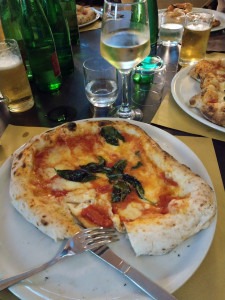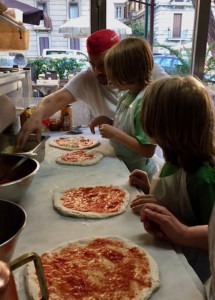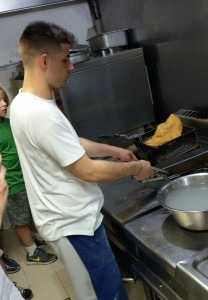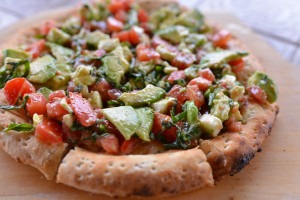Costa Rica's Favorite Meal: The Casado
February 7, 2025
Costa Rica is a fabulous destination for luxury travelers, as well as seniors, couples, and families, not least because of its many excellent dining options.…
Read This Post Happy National Pizza Day! Is pizza the most popular food on the planet? I haven’t done any research on the subject, but I’m sure it has to be. You can find it pretty much anywhere, and it is always recognizable as pizza, no matter how varied it may seem from place to place.
Happy National Pizza Day! Is pizza the most popular food on the planet? I haven’t done any research on the subject, but I’m sure it has to be. You can find it pretty much anywhere, and it is always recognizable as pizza, no matter how varied it may seem from place to place.
Some people are pizza purists, and they tend to like the pizza they grew up with. 
I’m a pizza omnivore, and like pretty much any pizza. To me the difference between a Neapolitan style pizza and Chicago stuffed pizza is like the difference between apples and oranges. Both are fruit, both are good. But they aren’t exactly the same thing, are they?
I grew up eating what I now know was run-of-the-mill midwestern “party-cut” (aka square-cut) pizza. The pizzeria was called “Millilo’s,” we loved it, and our favorite toppings were sausage and onion. When I moved to New York for school my first meal there was pizza from V&T on Amsterdam Avenue, which I still think has the best New York-style pizza to be found. When I was last in New York I got to take my husband and kids there. Heaven!
Then I went to Italy, and… wow. I can still remember the taste of that first thin-crust, wood fired pizza at la Pizzeria Economica (“cheap pizzeria”) in the San Lorenzo neighborhood near the University. The intensity of the flavors from those few simple but exquisite ingredients was unlike any pizza I’d ever had.
And then I moved to Chicago, where I learned pizza can take on a whole new dimension!
 Who invented pizza? Well, that depends on what you consider pizza. There have been types of flatbreads consumed for thousands of years, and some of them have included toppings. But the modern version of pizza is attributed to Naples, where it was a type of street food consumed by the poor since the Sixteenth Century.
Who invented pizza? Well, that depends on what you consider pizza. There have been types of flatbreads consumed for thousands of years, and some of them have included toppings. But the modern version of pizza is attributed to Naples, where it was a type of street food consumed by the poor since the Sixteenth Century.
 The most famous pizza from Naples is undoubtedly the one served to Queen Margherita, of the house of Savoy, after the unification of Italy in the Nineteenth Century. This pizza was made with tomatoes, mozzarella, and basil to mimic the colors of the Italian flag. And it is known as a “pizza Margherita” to this day!
The most famous pizza from Naples is undoubtedly the one served to Queen Margherita, of the house of Savoy, after the unification of Italy in the Nineteenth Century. This pizza was made with tomatoes, mozzarella, and basil to mimic the colors of the Italian flag. And it is known as a “pizza Margherita” to this day!
Pizza made its way to the United States with the arrival of Italian immigrants in the Nineteenth Century. But it gained in popularity following World War II with the return of American soldiers who had tasted it while stationed in southern Italy.
There are many different types of pizza in Italy, and even more if you start to count all types of focaccia and flatbread. But the most known are pizza napoletana, pizza tonda alla Romana, pizza al taglio (or pizza rustica), pizza al padellino, pizza siciliana (“sfincione“), and pizza fritta.
 1. Pizza Napoletana
1. Pizza NapoletanaWhat makes an authentic Neapolitan pizza? There are actually very strict rules! It is a thin-crust pizza, but not too thin, with a slightly chewy crust, thinner in the middle than on the edges. It uses a slow-leavened yeasted dough that must rise for many hours (even up to a day). It must be formed by hand, not by rolling pin, and must be fired in a domed, wood-fired oven. It also should not be too large, maximum 12-14 inches in diameter. The type of topping can vary, but the most famous versions are the aforementioned Margherita and pizza marinara, which is cheeseless and includes tomato, oregano, garlic, and olive oil.
Interestingly, though, in the rest of Italy a “pizza Napoli” is with tomato, mozzarella, and anchovies (and sometimes capers).
Learn more about what we love about Naples.
 2. Pizza Tonda alla Romana
2. Pizza Tonda alla RomanaIn Rome what is called pizza tonda–or “round pizza” to differentiate it from the Roman pizza al taglio–is a thin, wood-fired pizza that bears some resemblance to the pizza napoletana. However, pizza tonda is thinner, its crust crispier, and (because it is rolled out more thinly) usually is also larger in diameter.
 3. Pizza al Taglio
3. Pizza al TaglioPizza al taglio (or pizza rustica), unlike the two previous examples, is made in large rectangular pans. It is cooked in an electric oven, not wood-fired, and is usually eaten as street food. When eating pizza al taglio, you can choose from the many different toppings available, including such favorites as sausage, mushroom, Margherita, a tomato-less version with potatoes, and even varieties with cold salads on top.
The vendor will cut the amount you want from the large sheet (“al taglio” means “by the cut”) and weigh it. So although this is what you might refer to as an Italian version of pizza by the slice, it’s more properly pizza by the kilo!
This is a type of pizza from Turin. Unlike the round pizza napoletana and pizza tonda, it is baked not straight in the oven but in a pan, and in this sense is a bit more like an American pan pizza. The crust is thick and soft, except for a slightly crisp exterior due to the oil in the pan it is baked in. Like any pizza, it can be topped with a variety of toppings.
 5. Pizza Siciliana (“Sfincione”)
5. Pizza Siciliana (“Sfincione”)Sicilian pizza, like pizza al taglio, is baked in rectangular or square pans and is served as a snack or street food, but its crust is thicker and fluffier than that of pizza al taglio, almost like a spongy focaccia. It also doesn’t have the same variety of toppings, but usually comes with tomato, anchovies, oregano, and onions, and with or without cheese.
 6. Pizza Fritta
6. Pizza FrittaThe last pizza we’ll list is, like the first, from Naples. But pizza fritta is what it sounds like–fried pizza! It is the only type of pizza we’ve listed that is not flat, but rather stuffed like a calzone. Pizza fritta is the epitome of Neapolitan street food. Stories say that it developed during and after World War II when the price of wood made it hard to fire the wood ovens. However it came into being, it is a decadent and filling indulgence. The classic version is stuffed with local salami or ham, ricotta, mozzarella or provola cheese, and lardo, or pork fat. Yes, it is a pizza stuffed with fat and then fried!
 Interested in learning to make authentic Italian pizza? Many of our cooking vacations include a pizza-making class. From making the dough to firing it in the wood-burning oven, you’ll learn the tricks to making the best pizza.
Interested in learning to make authentic Italian pizza? Many of our cooking vacations include a pizza-making class. From making the dough to firing it in the wood-burning oven, you’ll learn the tricks to making the best pizza.
 So what about in the US? There are now Neapolitan-style pizzerias in many large cities, complete with wood-fired ovens, but that’s a development that has happened over the past few decades. And while everyone knows that New Yorkers cut their pizzas in triangles and Midwesterners cut theirs in squares, what are the differences beyond that?
So what about in the US? There are now Neapolitan-style pizzerias in many large cities, complete with wood-fired ovens, but that’s a development that has happened over the past few decades. And while everyone knows that New Yorkers cut their pizzas in triangles and Midwesterners cut theirs in squares, what are the differences beyond that?
The most known types of pizza in the US separated more by geography than by shape, and include: New York style, Detroit Pizza, St. Louis Pizza, California Pizza, and Chicago deep dish.
 1. New York Style Pizza
1. New York Style PizzaIt is no coincidence that New York style pizza bears the closest resemblance to Italian styles of pizza. It is round, hand-tossed, with a soft crust that is slightly thinner in the middle. It usually has only a handful of ingredients: pepperoni, anchovies, mushrooms, but isn’t piled full of them. It is cut in large triangles that are easy to fold over on themselves for easier eating. (Although Brooklyn-style pizza is slightly different, with a crispier crust.)
Detroit style pizza is a descendent of Sicilian pizza, and like it has a thick, spongy crust and is baked in large rectangular pans. One notable quirk: the use of local Wisconsin cheese instead of the more traditional mozzarella.
St. Louis has taken the traditional ingredients of pizza and tweaked them all. The crust is a non-yeasted dough, so it is thin and crisp. The sauce is sweet. Like they added sugar to it to make it sweet, not because they have special tomatoes! And the cheese is a local processed blend of provolone, Swiss, and white cheddar that is called Provel. St. Louis style pizza is served in the traditional Midwestern way of thin-crust pizza, cut into squares.
So yeah. St. Louis people are weird. Or at least their pizza is.
 4. California Pizza
4. California PizzaHeading further into the realm of “why did they do that to pizza,” we travel from St. Louis to California. California style pizza at least tastes good (sorry St. Louis!), but it is anything but traditional. It uses a leavened dough like Italian pizza, but from there the ingredients can include everything from smoked salmon and creme fresh, to local root vegetables, chicken, peanut sauce, and more.
 5. Chicago Deep Dish
5. Chicago Deep DishAlthough sometimes nothing but a New York style slice will satisfy me, I have been in Chicago now for almost thirty years, and there is no denying the awesomeness of Chicago deep dish pizza.
There are actually two kinds of deep dish pizza in Chicago, deep dish and stuffed. Both use a yeasted dough, tomato sauce, and a lot of cheese. Both are made in deep-edged, heavy pans, frequently cast iron, sometimes steel. The large amounts of toppings make Chicago pizza more of a savory pie than a flatbread, and it is therefore as filling as you might expect. The yeasted dough frequently includes not only standard wheat flour but also cornmeal or semolina, giving it a slightly different texture. And the pans are heavily oiled, so that the outside of the dough has a crisp, lightly fried consistency. The toppings are placed on the pie in an inverted order: cheese, then toppings like Italian sausage, pepperoni, spinach, or mushrooms, and then the sauce on top. This is because the thickness of the pizzas requires a long back time–30 to 40 minutes or more–which would burn the cheese if the pizzas were constructed differently.
Chicago stuffed pizza, like you might guess, has the fillings inside two layers of dough. It is constructed like a standard deep dish pizza, but with an additional, thin layer of dough placed on top of the fillings and before the sauce.
 For the record, we do have thin crust pizza in Chicago as well. It is tasty but unremarkable, a round pie on a yeast-leavened crust, traditionally topped and cut into squares.
For the record, we do have thin crust pizza in Chicago as well. It is tasty but unremarkable, a round pie on a yeast-leavened crust, traditionally topped and cut into squares.
So what is your favorite type of pizza? Are you a pizza purist, or do you enjoy trying the pizza no matter where your travels take you?
By Peg Kern
Sign up to receive our newsletter, which includes travel tips, recipes, promotions, and information on our best cooking vacations.
Find more photos, videos, food facts, and travel stories from The International Kitchen on Facebook, Instagram, and YouTube.